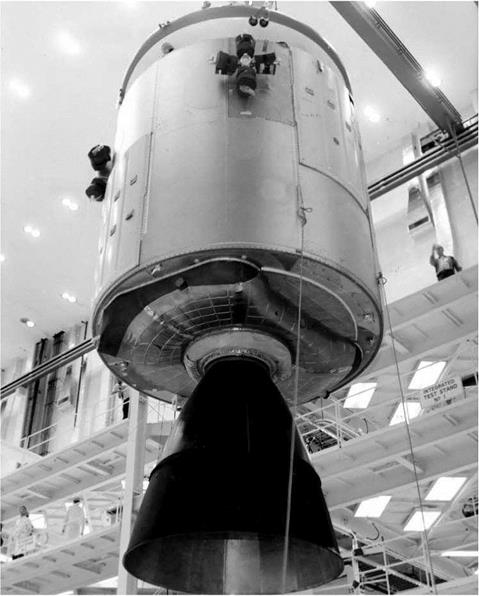Apollo
The three-man Apollo would be launched to the Moon using a Saturn V megabooster, with two of the crew landing on the surface of the Moon. The trip utilised the Lunar Orbit Rendezvous (LOR) method, in which an Apollo Command and Service Module (CSM) mother ship and a Lunar Module (LM) would fly to the Moon together. Initially, Apollo Command and Service Modules, termed Block I, were to be tested in Earth orbit for up to 14 days, before sending improved spacecraft (Block II) into deep space or around the Moon on solo test flights prior to man-rating the LM in a series of flight tests. Following the initial lunar landing, a series of exploration missions (up to nine) were planned to explore the local vicinity, using flying and roving vehicles to assist the astronauts who would spend four or five days on the Moon and about a week in orbit. A follow-on programme called Apollo Applications (Block III) would see expansion of the lunar landing programme to missions of up to two weeks on the surface, supported by a small S-IVB space station and leading to the creation of a lunar research base in the 1980s.
The loss of the Apollo 1 crew in 1967 cancelled all Block I Apollo missions. The first manned flight (Apollo 7) was a CSM-only mission, as was Apollo 8, the first manned lunar orbiting mission. Apollo 9 tested the CSM/LM combination in Earth orbit, and Apollo 10 repeated the feat in lunar orbit. This led to the Apollo 11 lunar landing in July 1969. By then, ten landings were manifested and others planned. However, a variety of social, political and hardware issues, notwithstanding the Apollo 13 aborted lunar mission that almost cost the lives of the crew, terminated the Apollo lunar landing programme with the sixth landing – Apollo 17.
Apollo 7, weighing 14,694 kg (32,400 lb) in orbit, comprised two of the three Apollo Moon landing flight modules, namely the Command and Service Modules. The Command Module was 3.48m (11.4ft) high and 3.91m (12.8ft) in diameter. It weighed 5,556 kg (12,251 lb) and comprised heat shields, 12 reaction control system thrusters, a triple main parachute landing system, computers, waste management, hot water and food. The atmosphere of the 5.95 m2 (64 ft2) cabin was gradually changed from a 60/40 oxygen/nitrogen mix at 15 psi to a 5 psi pure oxygen atmosphere after liftoff. The Service Module, including the UDMH-nitric oxide, 9,752 kg (21,503 lb) thrust Service Propulsion System with its 2.8 m (9 ft) long nozzle, was 7.49 m (24.5 ft) long and the same diameter as the Command Module. It contained the fuel tanks for the SPS, fuel cells for the electrical and water generation system, pumps, radiators and a series of RCS thrusters. Apollo 7 Command Module 101 was a lighter weight CM/SM combination than on later flights. Apollo 8, CM103, weighed 28,901kg (63,727 lb)
|
The Apollo Service Module and Service Propulsion System engine |
and included, for the first time, the high-gain steerable S-band antenna of four 78 cm (31 in) diameter parabolic dishes mounted on a folding boom at the aft end of the Service Module.
The combined Apollo 9 CM104, LM3 modules weighed 36,559kg (80,613lb) in orbit. The two-stage aluminium-aluminium alloy LM, which was not designed to
|
Table 3.1. Apollo Lunar Landing mission details
|
withstand re-entry, was 6.98 m (23 ft) tall. The descent stage was an octagonal structure, 3.22 m (10.5 ft) high, with a maximum diameter of 4.29m (14 ft). With four landing legs deployed, the LM measured 9.44 m (31 ft) tall. The landing struts were made of crushable aluminium honeycomb and each 0.9 m (3 ft) diameter footpad had surface sensing probes to signal descent engine shutdown. One of the legs had a ladder, extending from the porch of the ascent stage crew hatch. The descent engine was surrounded by equipment bays, holding fuel and gas tanks, navigation and guidance systems, and science equipment used on lunar missions. The descent stage was covered in Mylar-aluminium alloy for thermal and meteoroid protection. The ascent stage was 3.75 m (12 ft) high, with a maximum diameter of 4.44 m (14.5 ft). It contained a 7.16 m3 (253ft3) pressurised crew compartment, measuring 2.33m (7.5ft) by 1.06m (3.5ft). The ascent stage also included an ascent engine, docking port and tunnel, guidance and navigation, and life support systems. The total weight of the first manned Lunar Module was 4,450kg (9,812lb). Apollo 11 (CM107, LM5) weighed 43,869.6kg (96,732 lb). Apollo 15 (CM112, LM8) weighed 46,785.35 kg (103,162 lb). This was a new J-series mission which incorporated enhanced Command, Service and Lunar Modules.











